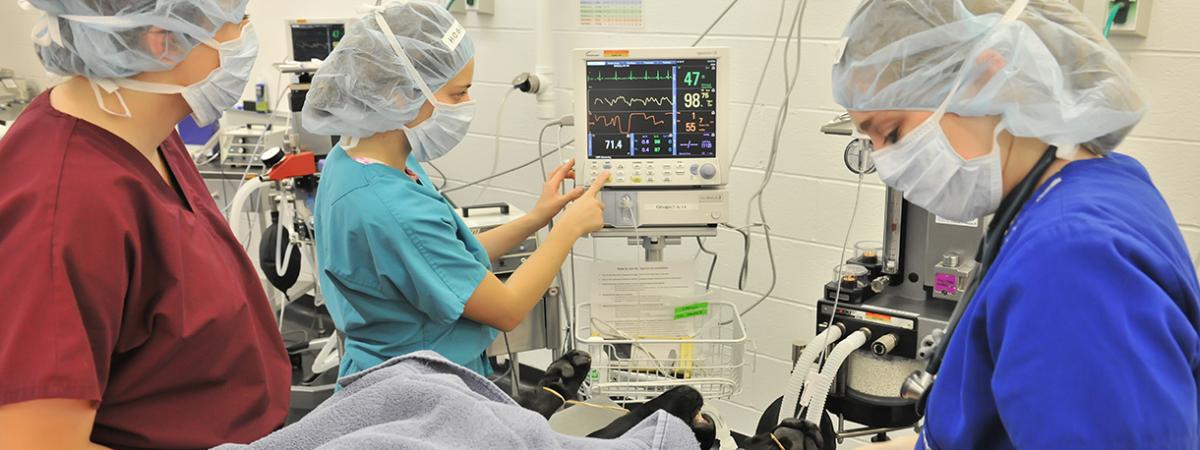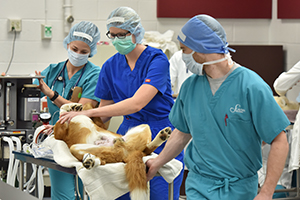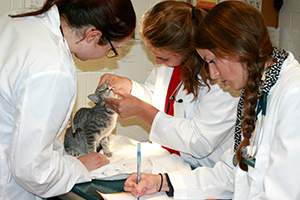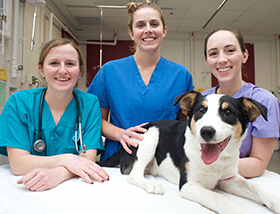


Mattie Hogg, third-year veterinary student, walks into the junior surgery suite and meets with the rest of her surgical team. The team will neuter a two-year-old, black Labrador retriever mix named Jake.
Hogg and her team are one of 10 teams that afternoon who will perform spay and neuter surgeries on shelter animals as part of a semester-long course. This required course is a new and expanded surgical training lab for third-year veterinary students. During the surgery lab, the students are responsible for all aspects of pre-surgical evaluation and physical exam, anesthesia, surgery, recovery and post-surgical care. They also provide wellness care. After the animals have recovered, they stay for evaluation for a couple of days and then they are returned to the shelter for adoption.
Since inception of the new program in the fall of 2016, third-year students have spayed/neutered and cared for 1,085 dogs and cats. Currently there are 25 shelters and rescues in Iowa that participate in the program.
“The program is a win-win for the shelters and the college,” says Dr. Joyce Carnevale, assistant clinical professor of veterinary clinical sciences at Iowa State’s College of Veterinary Medicine.
“The spay/neuter and preventive care program is offered at no cost to the shelters which allows them to use their limited funding in other ways,” Carnevale said. “For veterinary students, the new, expanded program gives the third-year students hands-on, clinical and surgical experiences with live animals prior to the fourth-year clinical rotations. In addition to the surgeries, they perform diagnostic testing, examinations, and general wellness care.”
The Real Deal
Unlike most of the veterinary classes during the first two years of veterinary school, this lab is hands-on training with live patients – and that can be challenging and stressful.
“There is more pressure on the students, more accountability,” says Dr. Tamara Swor, course coordinator. “These are live animals. Many are already adopted or will soon be.”
For Hogg, it’s a challenge that she welcomes. “As the surgical team, we are responsible for every aspect of the procedure,” she said. “We’ve met the patients before the surgery, and it’s easy to begin to care for them and want the best outcome.”
“Simulation models have a place in learning clinical and surgical skills but they only go so far,” Hogg says. “Getting used to real skin and tissue is very different from the model and it’s one of the biggest challenges when we start working with live animals.”
An extraordinary teaching aspect of the partnership with the shelters is that the course gets animals ranging from puppies to seniors. “Our students get exposed to different health concerns with the different life stages,” Swor says. “The spay/neuter procedure is the same, but the students may be challenged with different complications. It’s hard to prepare them for that, but the variety of life stages of patients is exactly what happens in practice.”
Hogg took the course in the fall of 2017, when shelters in Ames were receiving animals that were displaced by the Texas hurricanes. “We were able to see cases and disease processes that we might not normally see in animal populations in central Iowa,” Hogg said.
For Christina Collins (’18), the course provided a good foundation of skills for her fourth-year rotations. “The outreach component of the course gave me practice performing a physical exam, and to become more comfortable using an otoscope and an ophthalmoscope,” Collins said. “I also became more comfortable with vaccination requirements based on age and prior vaccine history. We also checked for parasite infections so I got microscope time and a chance to refresh my memory on antihelminthic treatments.”

1,000th Patient
In February the Surgery, Anesthesia and Community Outreach Program treated its 1,000th patient since the program was revamped in the fall of 2016. Ford’s surgical team (from left): Abigail Ruane, Megan Liegel and Jessica Usner
Teamwork and Communication
At the beginning of the course, students are assigned in groups of three. In a class of 150, often the group may not know each other. The same group of three stays together for the course. Each week the group alternates between being the “intake” team for the surgery patients, and the “surgery” team for the patients.
When the group is the “intake” team, they are receiving patients that are going to surgery in two to three days. “It’s the job of the intake team to make sure all of the pre-operative blood work and preventive care is completed. The patient is transferred to the surgery team the night before surgery” Hogg said.
As lead surgeon, it was Hogg’s job to meet her patient Jake the night before surgery to assess any problems that the team might be dealing with the next day. The anesthesiologist on the team meets the patient the morning of surgery and works on the anesthesia plan. The assistant surgeon helps perform some of the procedure and helps close the incision. The team decides among themselves who will monitor and check up on the patient the next two days before the patient goes back to the shelter.
“Learning to work as a team was critical,” Hogg said, “and communication among our team was the key to being successful.”
Swor added, “Surgery is about teamwork. But, as veterinarians, they will still need those team-building skills outside the operating theater as they work with their receptionists, veterinary technicians and their colleagues.”
Confidence Builders
The surgery lab is, no doubt, is an exciting and terrifying experience. Helping students through the course are faculty, residents and veterinary technicians.
“The technicians are just as important as the surgeons in this program,” Hogg said. “They are invaluable to our education. They are patient with our learning process and often give us helpful tips while we work with the animals.”
Diane Perry, surgery technician, says, “The most satisfying aspect of my job is seeing the growth of the students through the semester, and helping any way that I can whether it’s answering questions, holding a patient, or teaching a new trick to make something easier.”
“Anesthesia is probably the most challenging and intimidating for students,” says Lisa Smith, anesthesia technician. “I try to be a calming influence when students are stressed and provide support to help them through the process.”
Like Perry, Smith enjoys working with students. “The greatest reward is seeing a student who has struggled at the beginning of the year become comfortable by the end of the course.”
“As the semester went along, our confidence improved,” Hogg said. “When students are stressed, we are our own worst critics.”
“There’s stress in the course,” says Swor, “but we try to make it a good learning environment.”
“During Jake’s surgery, Dr. Swor was patient and very encouraging,” Hogg said. “There are times during the course that you feel more comfortable with one of the faculty surgeons nearby, and other times you are more comfortable with a little bit of space. The surgeons are great about providing safe learning opportunities to fit students’ differing confidence and skill levels.”
Forever Homes
“I was really proud to be part of this course,” Hogg said. “Besides the clinical and surgical skills we learned, we were able to give back to the community by taking care of these animals.”
April 2018
